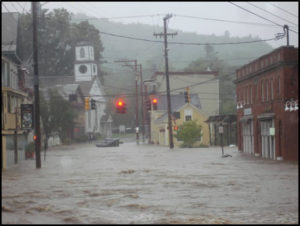Earlier this year, the American Planning Association’s Hazard Mitigation and Disaster Recovery Planning Division, in cooperation with Texas A&M University, sponsored a student paper contest for students in urban planning programs across the country. The papers would need to deal with some aspect of natural hazards and planning. The contest involved a $2,500 prize and presentation of the award at APA’s National Planning Conference, which just occurred in New York City May 6-9. The award was announced at a joint reception of the hazard division and APA’s Sustainable Communities Division on May 8. As might be expected, numerous papers were submitted by students in graduate planning schools across the U.S..
To my surprise and great pleasure, the winner of this first-ever contest was one of my own students from a course I teach at the University of Iowa School of Urban and Regional Planning. Emily Seiple, of Mahomet, Illinois, was in my Fall 2016 class, “Planning for Disaster Mitigation and Recovery.” She was one of three students who sought my endorsement to submit their papers, but there were undoubtedly dozens of others, if not hundreds, from other schools. I have not inquired as to the total submitted.
Emily’s paper is very deserving of the recognition she has now received. In her paper, written as an assignment for my class, she expertly dissected the dynamics of a challenging recovery situation for the town of Waterbury, Vermont, following Hurricane Irene in the fall of 2011. Many readers may recall seeing television footage of glutted streams rushing downhill from the mountains, inundating one Vermont community after another. The flood itself was but the prelude, however, for then followed the arduous work of organizing recovery committees, managing recovery funds, working with state and federal agencies, and finding and implementing the silver lining in an otherwise bleak situation. Resilience involves a community’s ability both to respond well to such challenges and to build back better and stronger. Emily examined that story with a remarkably clear and perceptive eye to both details and the big picture, as you will learn by reading her paper, linked here. I present it because I believe her recpaper will allow blog readers to gain a greater understanding of the many nuances involved in disaster recovery planning, which has never been a simple subject.
I took the extra step, during the APA National Planning Conference, of arranging to videotape an interview with Emily Seiple about her paper, with the help of Michael Johnson of the APA staff. It may be two or three weeks before that video is posted, but you will ultimately be able to find it on the APA website, at www.planning.org. We will also arrange to post the paper on that site. I invite reader comments on both the paper and its subject matter.
Finally, I apologize to my readers for the relative shortage of postings in recent weeks. The final months of my tenure at APA, leading to my working independently as a writer, consultant, and speaker as of June 1, have been surprisingly hectic, and I want to be sure that I leave the APA Hazards Planning Center in good hands and in excellent shape. That has taken priority, but the end is near, after which I hope to give this blog considerably closer attention well into the future.
Jim Schwab
